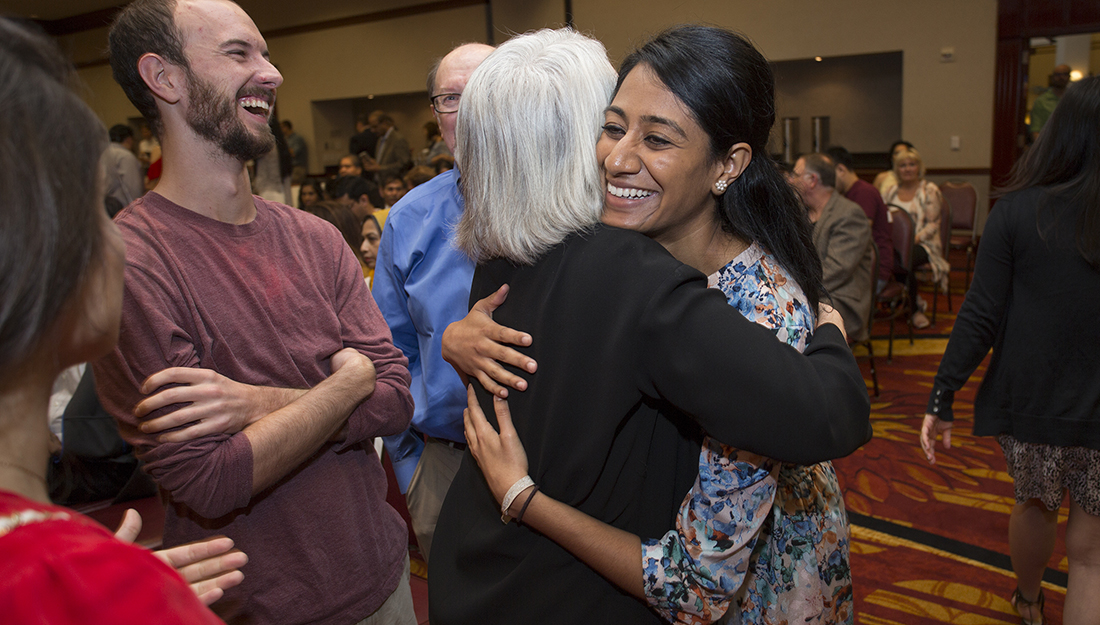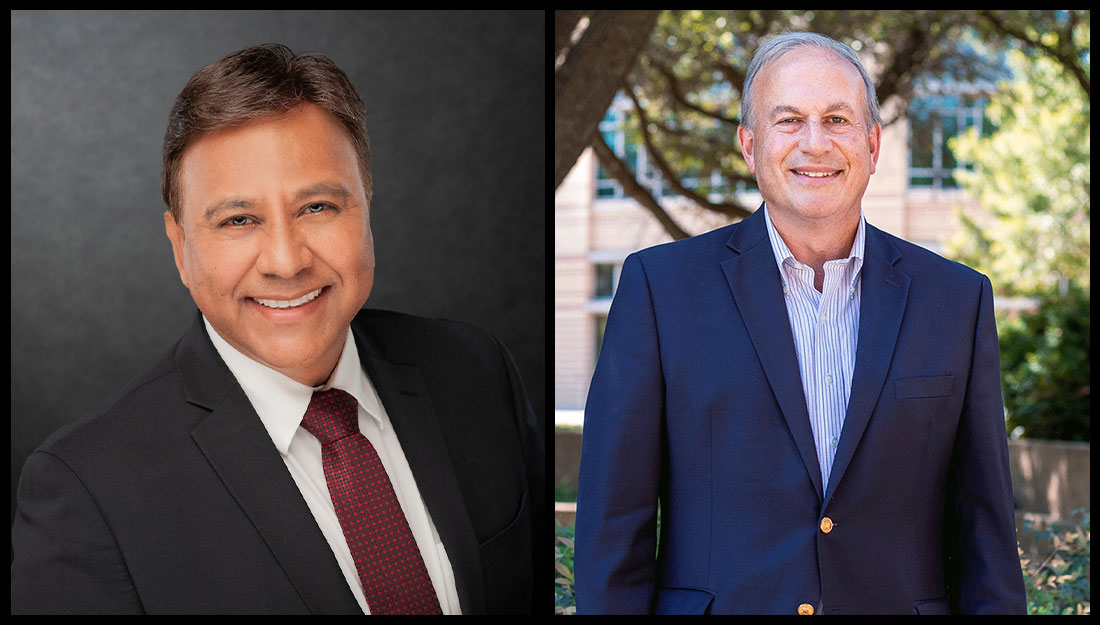Texas A&M medical students meet their match

For fourth-year medical students eager to take the next step in their medical careers, it’s all about the Match: The moment where nearly 36,000 students across the country learn, in a simultaneous nationwide reveal, where they will be headed to complete their residency training.
The air was filled with a sense of excitement as 179 fourth-year Texas A&M students met in Round Rock, home of one of the college’s five medical school campuses, to open the envelopes that contained their assigned residencies.
After a celebratory skit featuring several faculty entering the ballroom, each student was called to the stage and handed their future–one envelope at a time. Spouses sat anxiously next to their medical student partners, waiting to learn where in the country they will be relocating. Some students walked up to the podium carrying infants or holding hands with young children. Cheers, laughter, shrieks, and tears served as the soundtrack to a sea of hugs, high-fives, and letter-waving as students ripped open the envelopes containing their future.
The impact of Match on medical students
The culmination of countless hours of studying, test taking, lectures and clinical rotations, Match Day is held annually on the third Friday in March. It’s the final step of a year-long process that matches graduating medical students with residency programs in their desired specialty. Residencies are the “graduate” portion of medical education.
During the first half of their fourth year, medical students apply for and then interview with their desired programs. Then, students submit their list of choices in order of preference–and at the same time residency program directors submit their rank-ordered lists of preferred candidates–to the National Residency Matching Program. A computer then matches each student to the residency program that is highest on the student’s list and that has offered a position to the applicant. Residency programs can vary in length from three years for general medicine/family practice specialties to eight years for the most specialized of surgeons.
A record-high 35,969 U.S. and international medical school students and graduates vied for 31,757 positions, the most ever offered in the Match.
In the end, Match is one of the most important steps to a medical student achieving their dream of not only becoming a physician, but also determining what type of doctor they will become.
For Katherine Kerwin, that dream is becoming a plastic surgeon. She matched in plastic surgery, one of the most difficult specialties to be placed in. She’s headed to Indiana School of Medicine in Indianapolis. Later she plans to pursue a fellowship in craniofacial surgery and open a private practice affiliated with an academic institution.
“Texas A&M has taught me not only the fundamentals of medical science, but also the impact of medical care, Kerwin said. “Our [Texas A&M] educators and classmates have expanded my own understanding of what a physician’s role is within their community and the importance of their service.”
John (Jack) Ogden is headed to an internal medicine residency at the prestigious Mayo Clinic, Rochester.
“I chose Internal Medicine because I like the comprehensive view of each patient that the field requires. I also like the broad knowledge that Internal Medicine physicians have by the end of their training, and how they can treat pretty much any disease they are presented with,” Ogden said.
In addition to the students who participated in the Match, Texas A&M also has several students headed to residencies within the U.S. military branches. While they don’t actually participate in the Match, some, like Mark Ahlenius, attended the Match Day festivities to celebrate with their colleagues. Ahlenius will be commissioning in the Army and will complete a pediatrics residency in San Antonio, Texas.
Ahlenius has been part of the A&M Integrated Medicine (AIM) program at the College Station campus. Rather than studying the six core disciplines in isolated blocks, AIM students work with physicians in core specialties continuously throughout the year, simultaneously following a panel of patients. The non-traditional model allowed Ahlenius the chance to work with a rural pediatrician, and helped confirm his decision to pursue a career in pediatrics.
“It was an experience I fell in love with because I was able to see how a doctor can affect a local community. That’s a core principle A&M instills: the relationship and duty a physician carries within their community,” he said.
Ahlenius, who is currently fostering six children with his wife, said “I am excited to be able to work alongside military families as a doctor. I am looking forward to working with soldiers on what they face abroad, as well as coming home to their families and raising children.”
The impact of Match on Texas communities
Doctors tend to practice medicine in the state they complete their residencies, making Match Day particularly significant to not only medical students, but also for the patients and communities they’ll impact in the future.
Texas A&M medical students matched in residency positions coast-to-coast from New York to California, with 56 percent remaining in Texas.
Additionally, half the students who were matched into Texas residencies (or 50 of 101) were placed into primary care placements. These placements are significant given the state’s critical shortage of primary care physicians.
Thirty-five counties in Texas have no physician of any kind, 80 counties have five or fewer physicians and 147 counties have no OB-GYN. Recently, Texas A&M was ranked among the top in the nation when it comes to staying in the state to practice, entering primary care and locating in underserved and rural areas by the Missions Management Tool 2017 report, published by the Association of American Medical Colleges (AAMC).
“As an institution dedicated to serving the needs of Texas, not only is it important that we produce graduates who help fill the residency positions within Texas, but that we also do everything we can to increase the number and quality of residency positions in our state,” said Carrie L. Byington, MD, dean of the Texas A&M College of Medicine, senior vice president of the Texas A&M University Health Science Center and vice chancellor for health services at The Texas A&M University System.
Texas A&M College of Medicine and its affiliated hospitals sponsor about 97 programs across the state. Three of these programs are run by the college: Texas A&M Family Medicine Residency, Texas A&M Sports Medicine Fellowship and Texas A&M Preventive Medicine Residency. Texas A&M’s other residency programs are created and maintained through collaborations with affiliate hospitals. Texas A&M helps serve as the academic component to graduate medical education by helping to round out the full residency experience.
In 2016, through expanded affiliations with Texas A&M’s medical education partners, Baylor University Medical Center, DeTar, and Houston Methodist, an additional 485 residency positions came under the medical school’s umbrella. The academic partnership is critical for maintaining these positions going forward while growing the programs where possible. In total, A&M College of Medicine was affiliated with 1,128 residency positions across the state by October 2016.
Also in 2016, the Texas Higher Education Coordinating Board awarded 14 graduate medical education planning and partnership grants to fund new programs. Of these, A&M and/or its partners received four of the grants.
“It is vital that we continue to work with our affiliates to create and support residency positions within Texas,” Byington said. “We believe that this is one of the most powerful ways to help alleviate the physician shortage and get Texans the health care they need.”
Media contact: media@tamu.edu


